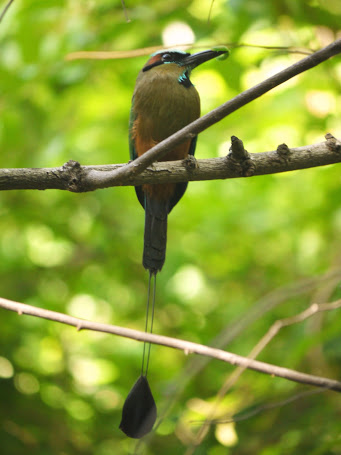Nicaragua does not have an officially designated national bird. Nonetheless, the Turquoise-browed Motmot (
Eumomota superciliosa) is widely regarded as the national bird. Its imagery permeates the symbology of the country, even appearing on the recently issued 200-cordoba note. All Nicaraguans love this bird, to be sure. Its name in Nicaraguan Spanish is
Guardabarranco, or Bank Keeper.
 |
| A Turquoise-browed Motmot brings a caterpillar to the chicks in a nest on the patio of Estacion Biologica Laguna de Apoyo. Photo Jeffrey McCrary. |
This year marked a first. On our, not exactly expansive, patio, a pair of Turquoise-browed Motmots decided to nest. The nest conditions they require has spawned their Nicaraguan name: They choose a horizontal hole in a dirt bank, usually previously made by small reptiles, then expand and lengthen it. The nest is protected from some kinds of potential predators by its location that can be reached only with difficulty by small, clawed animals that can scale the wall, or by flying; by the length of the nest and usually a crook in the access tunnel, which makes any trip into the tunnel treacherous; and by extreme stealth on entering and leaving the nest.
 |
| The 200-cordoba note, made of plastic, features none other than the Guardabarranco. |
The nest site was a drainage hole, placed in a stone retaining wall. It is shielded from easy view by a mahogany tree, but is less than two meters from every person entering and leaving Estacion Biologica. There was just enough cover from the mahogany tree to permit the birds to enter and leave without being easily noticed.
 |
| A juicy caterpillar is on its way to chicks in the Turquoise-browed Motmot nest. Photo Jeffrey McCrary. |
Once the eggs have hatched, the real work begins. Hungry chicks demand a lot of food, with particular nutrition profiles, particularly lots of protein. Both parents hurriedly made forays into the garden below and the jungle behind in search of fruits and especially small animals.
 |
| The Turquoise-browed Motmot, caterillar in tow, is waiting for its mate to emerge from the nest, to ferry more food to them. Photo Jeffrey McCrary. |
We were too busy to monitor the nest constantly. Furthermore, the parents noted whether someone was observing before entering or leaving the nest. We chose to act casually, let them do their thing, and hope for the best. This species is abundant in the Laguna de Apoyo Nature Reserve, some nests are found only 40 meters from our gate, but this first use of our own property made us proud.
 |
| The Turquoise-browed Motmot is uncharacteristically abundant in Laguna de Apoyo Nature Reserve. Photo Jeffrey McCrary. |
We never saw the chicks depart, and the large numbers of nearby birds of this species makes it impossible to state which bird came from where. Whether they survived and fledged, we can only speculate. Hopefully, because we try to make our grounds more natural and friendly to wildlife, the nesting pair was able to use a new site successfully, and perhaps we will get another visit in the future.
One does not have to be an expert to enjoy birdwatching. If you would like to see this gorgeous bird and lots of other forest birds, ask us to provide a field guide for a short excursion. Birdwatching is an inclusive, learning and enjoying activity, in which beginners can participate. Contact us if you would like to make a
birdwatching excursion.






No comments:
Post a Comment